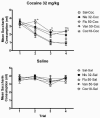Differential involvement of the norepinephrine, serotonin and dopamine reuptake transporter proteins in cocaine-induced taste aversion
- PMID: 19376154
- PMCID: PMC3089432
- DOI: 10.1016/j.pbb.2009.04.009
Differential involvement of the norepinephrine, serotonin and dopamine reuptake transporter proteins in cocaine-induced taste aversion
Abstract
Despite the impact of cocaine's aversive effects on its abuse potential, the neurochemical basis of these aversive effects remains poorly understood. By blocking the reuptake of the monoamine neurotransmitters dopamine (DA), norepinephrine (NE) and serotonin (5-HT) into the presynaptic terminal, cocaine acts as a potent indirect agonist of each of these systems. The following studies attempted to assess the extent of monoaminergic mediation of cocaine's aversive effects using conditioned taste aversion (CTA) learning [Garcia, J., Kimeldorf, D.J., Koelling, R.A., Conditioned aversion to saccharin resulting from exposure to gamma radiation. Science 1955;122:157-158.]. Specifically, Experiment 1 assessed the ability of selective monoamine transporter inhibitors, e.g., DAT (vanoxerine), NET (nisoxetine) and SERT (fluoxetine), to induce taste aversions (relative to cocaine). Only the NET inhibitor approximated the aversive strength of cocaine. Experiment 2 compared the effects of pretreatment of each of these transport inhibitors on the development of a cocaine-induced CTA. Pretreatment with nisoxetine and fluoxetine both attenuated cocaine-induced aversions in a manner comparable to that produced by cocaine itself. The DAT inhibitor was without effect. Combined, the results of these investigations indicate little or no involvement of dopaminergic systems in cocaine's aversive effects while NE appears to contribute most substantially, with a possible modulatory involvement by serotonin.
Figures






Similar articles
-
Preexposure to cocaine attenuates aversions induced by both cocaine and fluoxetine: Implications for the basis of cocaine-induced conditioned taste aversions.Pharmacol Biochem Behav. 2010 Apr;95(2):230-4. doi: 10.1016/j.pbb.2010.01.011. Epub 2010 Feb 1. Pharmacol Biochem Behav. 2010. PMID: 20122955
-
Assessment of monoamine transporter inhibition in the mediation of cocaine-induced conditioned taste aversion.Pharmacol Biochem Behav. 2005 Nov;82(3):583-9. doi: 10.1016/j.pbb.2005.10.014. Epub 2005 Dec 6. Pharmacol Biochem Behav. 2005. PMID: 16337262
-
The stimulatory and inhibitory components of cocaine's actions on the 5-HTP-induced 5-HT2A receptor response.Pharmacol Biochem Behav. 1996 Nov;55(3):387-96. doi: 10.1016/s0091-3057(96)00108-6. Pharmacol Biochem Behav. 1996. PMID: 8951980
-
Dopamine reuptake transporter (DAT) "inverse agonism"--a novel hypothesis to explain the enigmatic pharmacology of cocaine.Neuropharmacology. 2014 Dec;87:19-40. doi: 10.1016/j.neuropharm.2014.06.012. Epub 2014 Jun 19. Neuropharmacology. 2014. PMID: 24953830 Review.
-
Cocaine, reward, movement and monoamine transporters.Mol Psychiatry. 2002;7(1):21-6. doi: 10.1038/sj.mp.4000964. Mol Psychiatry. 2002. PMID: 11803442 Review.
Cited by
-
Reinforcing and Stimulant-Like Effects of Methamphetamine Isomers in Rhesus Macaques.J Pharmacol Exp Ther. 2021 Aug;378(2):124-132. doi: 10.1124/jpet.121.000548. Epub 2021 May 13. J Pharmacol Exp Ther. 2021. PMID: 33986037 Free PMC article.
-
Dopamine mediates cocaine-induced conditioned taste aversions as demonstrated with cross-drug preexposure to GBR 12909.Pharmacol Biochem Behav. 2012 Aug;102(2):269-74. doi: 10.1016/j.pbb.2012.04.012. Epub 2012 May 3. Pharmacol Biochem Behav. 2012. PMID: 22579912 Free PMC article.
-
Endogenous Regulator of G protein Signaling 14 (RGS14) suppresses cocaine-induced emotionally motivated behaviors in female mice.bioRxiv [Preprint]. 2024 Sep 15:2024.09.12.612719. doi: 10.1101/2024.09.12.612719. bioRxiv. 2024. PMID: 39314405 Free PMC article. Preprint.
-
Adolescent male rats are less sensitive than adults to the anxiogenic and serotonin-releasing effects of fenfluramine.Neuropharmacology. 2013 Feb;65:213-22. doi: 10.1016/j.neuropharm.2012.10.010. Epub 2012 Oct 24. Neuropharmacology. 2013. PMID: 23103347 Free PMC article.
-
Profound reduction in sensitivity to the aversive effects of methamphetamine in mice bred for high methamphetamine intake.Neuropharmacology. 2012 Feb;62(2):1134-41. doi: 10.1016/j.neuropharm.2011.11.005. Epub 2011 Nov 18. Neuropharmacology. 2012. PMID: 22118879 Free PMC article.
References
-
- Anthony JC, Tien AY, Petronis KR. Epidemiological evidence on cocaine use and panic attack. Am J Epidemiol. 1989;129:543–9. - PubMed
-
- Baumann MH, Phillips JM, Ayestas MA, Ali SF, Rice KC, Rothman RB. Preclinical evaluation of GBR12909 decanoate as a long-acting medication for methamphetamine dependence. Ann N Y Acad Sci. 2002;965:92–108. - PubMed
-
- Blanchard DC, Blanchard RJ. Cocaine potentiates the defensive behaviors related to fear and anxiety. Neurosci Biobehav Rev. 1999;23:981–91. - PubMed
-
- Braveman NS. What studies on preexposure to pharmacological agents tells us about the nature of aversion-inducing treatment. In: Baker LM, Best MR, Domjan M, editors. Learning Mechanisms in Food Selection. Waco, Texas: Baylor University Press; 1977. pp. 511–30.
-
- Broadbent J, Muccino KJ, Cunningham CL. Ethanol-induced conditioned taste aversion in 15 inbred mouse strains. Behav Neurosci. 2002;116:138–48. - PubMed
Publication types
MeSH terms
Substances
Grants and funding
LinkOut - more resources
Full Text Sources

